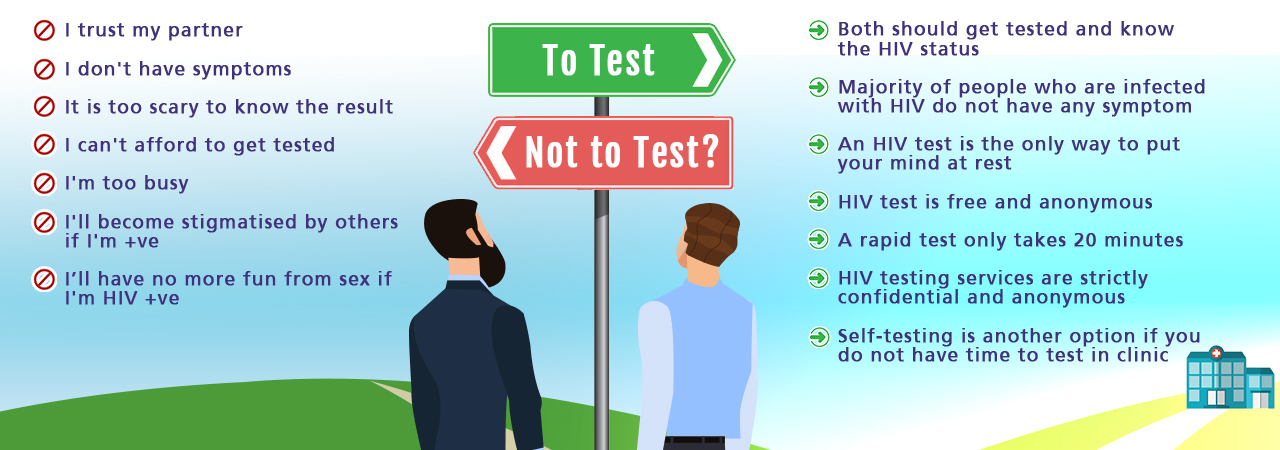HIV self-testing is a process by which a person who wants to know his or her HIV status collects a specimen, performs a test and interprets the test result in private. It does not provide a definitive diagnosis; instead, it is a screening test for the presence of HIV-1/2 antibodies or the HIV-1 p24 antigen. Any positive HIV result must be confirmed by laboratory-based testing with a venous blood sample.
By providing an opportunity for people to test themselves discreetly and conveniently, HIV self-testing may provide people who are not currently reached by existing HIV voluntary counselling and testing (VCT) services with information about their HIV status.
- Home self-testing:
This type of self-test requires users to perform the test and interpret the result all by his own. Instructions are usually given in the kits and on manufacturer websites, often with pictures or photos and sometimes even video demonstration.
- Home sample collection:
This type of self-test involves the users collecting a blood sample on their own and then sending the sample to a designated laboratory. The test is of laboratory standard and thus the result is definitive. Today, US is having programmes of home sample collection HIV testing. More:
Sample for HIV self-testing can either be blood or oral fluid. The use of different samples for testing will result in variation in the performance of the test, measured by sensitivity and specificity. The followings serve to give you an idea of different sample collection methods; users should follow the specific instructions given by the manufacturer of the test kit they intend to use.
- Blood: a blood drop is obtained from puncturing the finger-tip with a lancet and then milking out the blood, a collection device in the form of a pipette or a circular tube will then be used to transfer the blood drop to the reagents of the test kit.
- Oral fluid: a test stick with a pad at the end is used to swab the gums to collect the oral mucosal transudate; it is not the same as spitting out saliva.
HIV self-test kits recommended by World Health Organization
+
Globally, there are eight approved HIV self-test kits recommended by World Health Organization. (Information as of July 2018)
| Brand name |
Manufacturer |
Generation |
Sample |
Sensitivity |
Specificity |
Approval agency |
| atomo HIV Self Test |
Atomo Diagnostics, Australia |
3rd |
Blood |
99.7% |
99.7% |
CE |
| autotest VIH |
AAZ-LMB, France |
2nd |
Blood |
100% |
99.8% |
CE |
| BioSURE HIV Self Test |
BioSURE, United Kingdom |
2nd |
Blood |
99.7% |
99.9% |
CE |
| Exacto Test HIV |
Biosynex Group, France |
3rd |
Blood |
99.99% |
99.9% |
CE |
| INSTI HIV Self Test |
bioLytical Laboratories, Canada |
2nd |
Blood |
100% |
99.8% |
CE |
| OraQuick In-Home HIV Test |
OraSure Technologies, USA |
2nd |
Oral fluid |
100% |
99.8% |
CE |
| OraQuick HIV Self Test |
OraSure Technologies, USA |
Not available |
Oral fluid |
99.4% |
99% |
WHO |
| SURE CHECK HIV Self Test |
Chembio Diagnostic Systems, USA |
2nd |
Blood |
Not available |
Not available |
CE |
Source: Market and technology landscape: HIV rapid diagnostic tests for self-testing
Where to buy and pricing
+
- You can now register to order a free HIV self-test kit from the HIV Testing Service Website of the Department of Health. The website provides two kits to choose from, including oral fluid and blood (fingertip blood) kits. You will only be responsible for the shipping fee.
-
You can also purchase test kits at pharmacies or online platforms. Test kits with either CE approval, FDA approval or prequalified by WHO are preferred.
